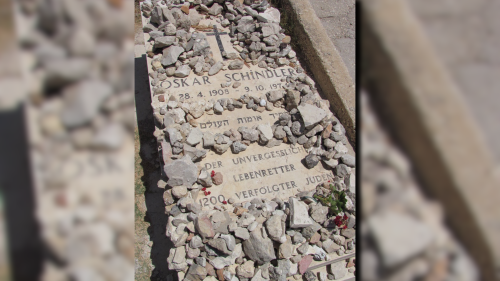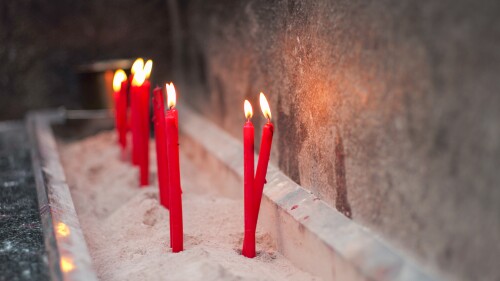As many of Israel’s critics portray it as collectively punishing the Palestinians, overlooked and unsaid is the greater frequency with which Muslims collectively punish the religious minorities living under their authority, often in atrocious ways.
Consider Egypt alone. The most recent attacks on Egypt’s Copts, culminating in the unprecedented besiegement of the St. Mark Cathedral, the holiest site of Coptic Orthodoxy, is the latest large-scale “collective punishment” of the nation’s indigenous Christian minority. Indeed, almost all of the major attacks on Copts are carried out in the context of collective punishment, based on the idea that, if just one Christian upsets Muslims, all Christians—and their churches and their women and their children—become fair game.
Collectively punishing “upstart” religious minorities who refuse to know their place in the Islamic order actually has doctrinal backing. According to Mark Durie, author of The Third Choice: “Even a breach by a single individual dhimmi [non-Muslim living under Muslim authority] could result in jihad being enacted against the whole community. Muslim jurists have made this principle explicit, for example, the Yemeni jurist al-Murtada wrote that ‘The agreement will be canceled if all or some of them break it…' and the Moroccan al-Maghili taught ‘The fact that one individual (or one group) among them has broken the statute is enough to invalidate it for all of them.’”
The latest collective punishment visited upon the Copts began in Khosous, near Cairo, on April 5, when a longstanding feud between a Christian family and a Muslim family—based on male Muslims sexually harassing Christian girls—culminated in the violent deaths of six Christians, including one set on fire, and one Muslim. In retribution, Muslims went on yet another “Friday-rampage"—Friday being the day Muslims meet and pray and hate and call for jihads on Christians—resulting in the injury of at least 20 other Copts, an attack on a Coptic church, and an Evangelical church set on fire.
Then, two days later, after Copts mourned their dead in their cathedral, Muslim mobs awaiting them outside launched yet another attack, one that was actually aided by state security, firing into the cathedral compound. Eyewitnesses said as many as 40-50 tear gas canisters targeted the mourners, many of whom were women and children. Other officers stood by as the Muslim mob tried to ravage the cathedral. Two more Copts were killed and many dozens wounded. Since then, more reports have emerged of Copts being targeted and some even killed.
The fact is, collectively punishing Christian Copts for the purported crimes of individual Copts is a regular occurrence in Egypt, and perhaps the chief mode of their persecution. Other recent examples include:
- July, 2012: When a Christian launderer accidently burned the shirt of a Muslim customer, a brawl ensued between the two Egyptians. The next day “the Muslim, with approximately 20 of his followers, went to the Christian’s home to attack him. Expecting this, the Christian was prepared and climbed to the highest point of his roof, hurling Molotov cocktails at the Muslims.” One Muslim man was injured and later died in a hospital. Before he died, between 2,000-3,000 Muslims attacked the Christians of the village, leading to an exodus of approximately 120 Coptic families. In the words of one report: “The sectarian crisis in the village of Dahshur escalated on August 1 after the burial of the Muslim man who died yesterday in hospital. Hundreds of Muslims torched and looted Coptic businesses and homes despite hundreds of security forces being deployed in the village. Eyewitnesses reported that security forces did not protect most Coptic property… As 120 families had already fled the village the day before after being terrorized, the businesses and homes were an easy game for the mob to make a complete clean-up of everything that could be looted… The security forces were at the scene of the crime while it was taking place and did nothing at all.” After the violence, the family of the deceased Muslim said that destroying Coptic property is not enough and that Copts have to “pay for their son’s death” with their lives.
- January, 2012: A mob of over 3,000 Muslims attacked Christians in an Alexandrian village because a Muslim accused a Christian of having “intimate photos” of a Muslim woman on his phone. Terrified, the Christian, who denied having such photos, turned himself in to the police. Regardless, Coptic homes and shops were looted and set ablaze. Three Christians were injured, while “terrorized” Christian women and children, rendered homeless, stood in the streets with no place to go. As usual, it took the army an hour to drive 2 kilometers to the village: “This happens every time. They [security] wait outside the village until the Muslims have had enough violence, then they appear.” None of the perpetrators were arrested. Later, in an effort to empty the village of its 62 Christian families, Muslims attacked them again, burning more Coptic property. According to police, the Muslim woman concerned has denied the whole story, and no photos were found.
- November, 2011: Similar to the above incidents in Khosous and Dahshur, the inadvertent killing of a Muslim by a Christian in a fight started by the Muslim when he torched the Christian’s home resulted in the “collective punishment of all Copts in the majority Christian village.” Two Christians not party to the altercation were killed; others were stabbed and critically wounded. As usual, “after killing the Copts, Muslims went on a rampage, looting and burning Christian owned homes and businesses.” Again, despite all this “Muslims insist they have not yet avenged” the death of their slain co-religionist; there were fears of “a wholesale massacre of Copts.” Once again, many Christians had fled their homes and were in hiding.
- April, 2011: When a Christian was falsely blamed for the deaths of two Muslims, an ensuing rampage left one Christian dead and 10 hospitalized; an old woman reportedly was thrown out of her second floor balcony. Christian homes and properties were plundered and torched.
- November, 2010: When a teenage Christian youth was accused of dating a teenage Muslim girl, 22 Christian homes were set ablaze to Islam’s war cry of “Allahu Akbar.” During the attack the Muslim mob threw fireballs, gasoline, and stones at Coptic homes and detonated butane gas cylinders.
One can find similar examples in other Muslim countries where religious minorities—especially Christians—live. In short, while other societies, particularly in the context of war, may collectively punish their enemies, Islam is the only “religion” that actually mandates it—that unjustly punishes large numbers of innocent people for the purported crimes of the individual, as the aforementioned clerics from one end of the Arab world to the other maintain. This alone should raise questions about the very nature of Islam.
Raymond Ibrahim is author of the soon-to-be-released book, Crucified Again: Exposing Islam’s New War on Christians. He is a Shillman Fellow at the David Horowitz Freedom Center and an associate fellow at the Middle East Forum.







